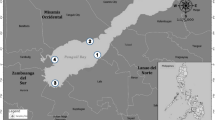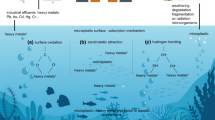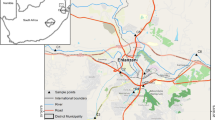Abstract
The acute toxicity of Cd to three stream invertebrates (Baetis rhodani Pict., Leptophlebia marginata (L.) and Pisidium sp.) was tested at pH 5 and 7 simultaneously in static (ST) and flow through (FT) systems. In the static design, the animals were kept individually in small boxes containing aerated stream water. In the flow through system, the three species were kept together in circular aquaria simulating stream ecosystems with patches of gravel and recirculating aerated stream water. The nominal Cd concentrations ranged from 0 to 5 mg 1−1 during an exposure period of 120 h.
The graphically obtained LC50 (120 h) values for B. rhodani were: pH 7: 2.3 mg 1−1 (ST), 2.5 mg 1−1 (FT) and pH 5: 3 mg 1−1 (ST), 1 mg 1−1 (FT). For L. marginata the following values were found: pH 7: > 5 mg 1−1 (ST), 4.4 mg 1−1 (FT) and pH 5: > 5 mg 1−1 (ST), 3.6 mg 1−1 (FT). Pisidium sp. showed a 100% survival in all Cd- and pH-treatments. From thee values it can be concluded that L. marginata is more tolerant than B. rhodani and that especially both species tolerated Cd better in the ST system than in the FT system, especially at pH 5.
At neutral pH the Cd-concentrations in the animals were higher than at low pH, probably due to surface adsorption of Cd onto the body. B. rhodani tended to molt more at low than at neutral pH.
Similar content being viewed by others
References
Bauer, J. & T. Fischer-Scherl, 1987. Biologische Untersuchungen zur Gewasservers auerung an nordostbayrischen Fliessgewassern. Fischer and Teichwirt 7: 216–222.
Campbell, P. G. C. & P. M. Stokes, 1985. Acidification and toxicity of metals to aquatic biota. Can. J. Fish. aquat. Sci. 42: 2034–2049.
Canton, J. H. & W. Slooff, 1982. Toxicity and accumulation studies of cadmium (Cd2+) with freshwater organisms of different trophic levels. Ecotox, Envir. Safety 6: 113–128.
Christensen, T. H., 1989. Cd soil sorption at low concentrations. Dissertation University of Copenhagen, Polyteknisk Forlag, 35 pp.
Clements, W. et al., 1989. The influence of water quality in macroinvertebrate community responses to Cu in outdoor experimental streams. Aquat. Toxicol. 14: 249–262.
Dressing, S. A. et al., 1982. Effect of chemical speciation on the accumulation of cadmium by the caddisfly Hydropsyche sp. Bull. envir. Contain. Toxicol. 28: 172–180.
Engblom, E. & P. E. Lingdell, 1984. The mapping of short term acidification with the help of biological pH indicators. Rep. Inst. Freshw. Res., Drottningholm 61: 60–68.
Förstner, U., 1984. Cd in sediments. Experientia 40: 23–29.
Gerhardt, A., 1990. Effects of heavy metals, especially Cd, on freshwater invertebrates with special emphasis on acid conditions. Introductory paper no 58, Lund University, Sweden.
Harmanen, M., 1980. Der Einfluss saurer Gewasser auf den Bestand der Ephemeriden- and Plecopterenfauna. Gewässer and Abwasser 66/67: 130–136.
Krantzberg, G. & P. M. Stokes, 1988. The importance of surface adsorption and pH in metal accumulation by chironomids. Envir. Toxicol. Chem. 78: 653–670.
Mackie, G. L., 1986. Tolerances of five benthic invertebrates to hydrogen ions and metals. Arch. Envir. Contain. Toxicol. 18: 215–223.
Monitor, 1987. Tungmetaller- forkomst och omsättning i naturen. Statens naturv⇍rdsverk, Solna, 182 pp.
Ökland, J. & K. A. Okland, 1986. The effects of acid deposition on benthic animals in lakes and streams. Experientia 42: 471–486.
Otto, Ch. & B. Svensson, 1983. Properties of acid brown water streams in South Sweden. Arch. Hydrobiol. 99: 15–36.
Ravera, O., 1984. Cd in freshwater ecosystems. Experientia 40: 2–14.
Siegel, S. & N. J. Castellan, Jr., 1988. Nonparametric Statistics for the Behavioral Sciences. 2nd edn. McGraw-Hill Book Company, New York.
Sokal, R. R. & F. J. Rohlf, 1981. Biometry. The Principles and Practice of Statistics in Biological Research. 2nd edn. Freeman & Company, New York.
Thorp, V. J. & P. S. Lake, 1974. Toxicity bioassays of Cd on selected freshwater invertebrates and interaction of Cd and Zn on the freshwater shrimp P. tasmaniensis. Aust. J. mar. Freshw. Res. 25: 97–104.
Wang, W., 1987. Factors affecting metal toxicity to (and accumulation by) aquatic organisms — overview. Envir. Int. Vol. 13: 437–457.
Warnick, S. G. & H. L. Bell, 1969. The acute toxicity of some heavy metals to different species of aquatic insects. JWDCF, 41: 280–284. In: Maciorowski, A. F., 1978: The development and assessment of an automated biological monitoring system using crayfish locomotor activity to detect toxic stress. PhD thesis, Virginia Polytechnic Institute Blacksburg.
Author information
Authors and Affiliations
Rights and permissions
About this article
Cite this article
Gerhardt, A. Acute toxicity of Cd in stream invertebrates in relation to pH and test design. Hydrobiologia 239, 93–100 (1992). https://doi.org/10.1007/BF00012575
Issue Date:
DOI: https://doi.org/10.1007/BF00012575




